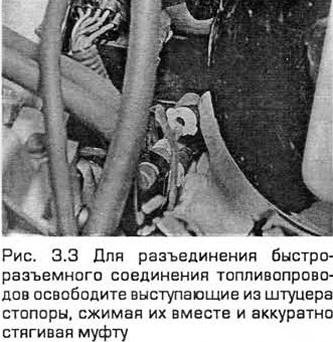Attention! Before you begin, please read the caution in paragraph 1 this chapter.
Removal and installation of quick couplings
1. Quick couplings are installed on all fittings of the fuel injection and drain lines.
2. Eliminate residual pressure before removing a fuel system component (paragraph 2) and equalize the pressure in the fuel tank by removing the cap from its mouth.
3. On early models, release the stoppers protruding from the fitting by squeezing them together and carefully tightening the sleeve. On later models, a special tool is used to disassemble the connection. With its help, the internal spring of the connection is unclenched. You can use a substitute for such a tool by twisting a piece of plastic tape and inserting it under the coil spring of the quick coupling. Use rags to absorb fuel spills. The fittings may be color-coded so as not to confuse them. If both fittings for connecting the fuel line are the same color, then remember the location of the fuel line for its subsequent correct installation (see fig. 3.3).

4. To connect the parts of the quick coupler, press them together so that the protruding stops snap into place in their groove. To restore pressure in the system, turn the ignition on and off five times. Before starting the engine, check for fuel leaks where the couplings have been disengaged.
Examination
5. see chapter 1.
Component Replacement
6. If you need to replace damaged sections, then use original hoses or pipes made of the same material. You cannot use anything else to replace it.
7. Before disconnecting the fuel system components, pay attention to how the hoses and pipes are laid and how the clamps and clamps are located. The new section of the system must be installed in the same way.
8. Before disconnecting any part of the fuel system, make sure that there is no pressure in the system (paragraph 2) and equalize the pressure in the fuel tank by removing the tank cap. Disconnect the negative battery cable as well (chapter 5 paragraph 1). Cover the connection to be disassembled with a rag to absorb fuel spills.
Visitor comments